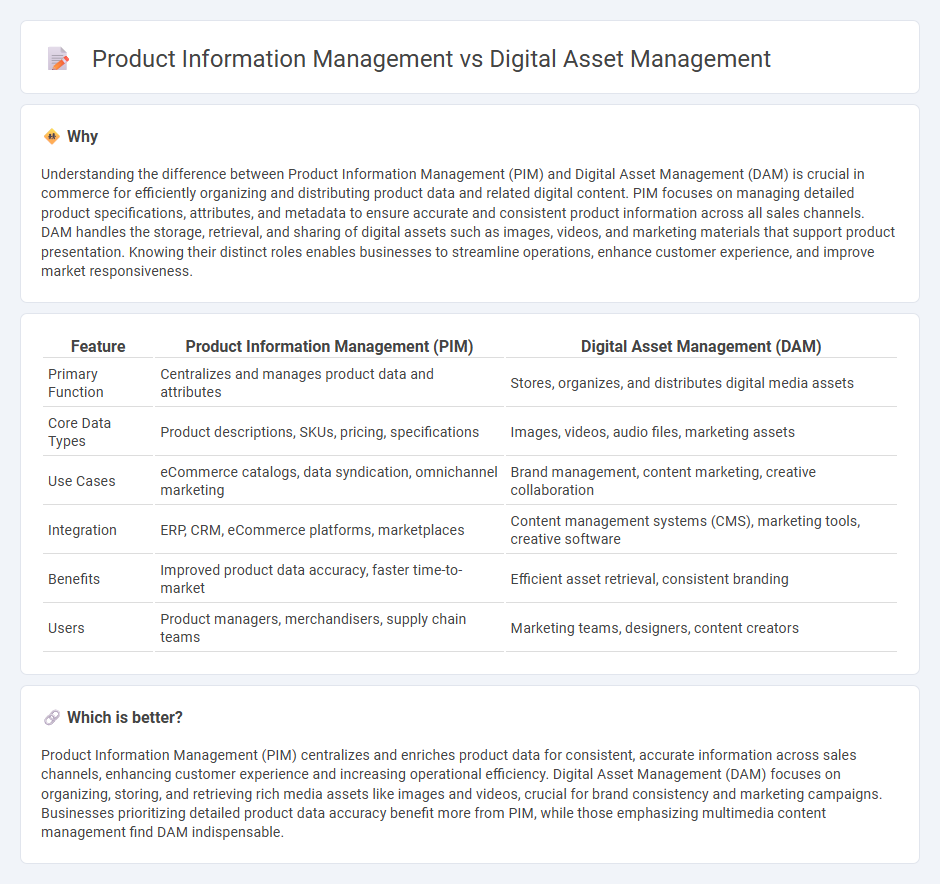
Product Information Management (PIM) centralizes and organizes product data to ensure accuracy and consistency across sales channels, enhancing the customer experience and operational efficiency. Digital Asset Management (DAM) focuses on storing, organizing, and distributing digital assets like images, videos, and marketing materials to streamline branding and content delivery. Explore the differences and benefits of PIM and DAM to optimize your commerce strategy effectively.
Why it is important
Understanding the difference between Product Information Management (PIM) and Digital Asset Management (DAM) is crucial in commerce for efficiently organizing and distributing product data and related digital content. PIM focuses on managing detailed product specifications, attributes, and metadata to ensure accurate and consistent product information across all sales channels. DAM handles the storage, retrieval, and sharing of digital assets such as images, videos, and marketing materials that support product presentation. Knowing their distinct roles enables businesses to streamline operations, enhance customer experience, and improve market responsiveness.
Comparison Table
| Feature | Product Information Management (PIM) | Digital Asset Management (DAM) |
|---|---|---|
| Primary Function | Centralizes and manages product data and attributes | Stores, organizes, and distributes digital media assets |
| Core Data Types | Product descriptions, SKUs, pricing, specifications | Images, videos, audio files, marketing assets |
| Use Cases | eCommerce catalogs, data syndication, omnichannel marketing | Brand management, content marketing, creative collaboration |
| Integration | ERP, CRM, eCommerce platforms, marketplaces | Content management systems (CMS), marketing tools, creative software |
| Benefits | Improved product data accuracy, faster time-to-market | Efficient asset retrieval, consistent branding |
| Users | Product managers, merchandisers, supply chain teams | Marketing teams, designers, content creators |
Which is better?
Product Information Management (PIM) centralizes and enriches product data for consistent, accurate information across sales channels, enhancing customer experience and increasing operational efficiency. Digital Asset Management (DAM) focuses on organizing, storing, and retrieving rich media assets like images and videos, crucial for brand consistency and marketing campaigns. Businesses prioritizing detailed product data accuracy benefit more from PIM, while those emphasizing multimedia content management find DAM indispensable.
Connection
Product Information Management (PIM) systems centralize and organize detailed product data, ensuring consistency across sales channels, while Digital Asset Management (DAM) systems store and manage multimedia content like images, videos, and documents associated with those products. Integration between PIM and DAM streamlines the synchronization of product descriptions, specifications, and rich media assets, enhancing online catalogs and customer experience. This connection enables efficient content updates, reduces errors, and accelerates time-to-market for e-commerce businesses.
Key Terms
Metadata
Digital asset management (DAM) centralizes metadata related to multimedia files such as images, videos, and documents, enhancing searchability and digital content organization. Product information management (PIM) focuses on enriching product metadata including SKUs, descriptions, specifications, and pricing to ensure consistency across sales channels. Explore how optimizing metadata within DAM and PIM systems can streamline workflows and improve data accuracy.
Centralized repository
Digital asset management (DAM) systems specialize in storing, organizing, and distributing rich media files such as images, videos, and documents, optimizing brand consistency and marketing workflows. Product information management (PIM) platforms centralize detailed product data, including descriptions, specifications, and pricing, to ensure accurate and consistent information across multiple sales channels. Explore how choosing the right centralized repository can streamline your content and product data operations for better efficiency.
Distribution channels
Digital Asset Management (DAM) centralizes storing, organizing, and distributing digital content like images, videos, and marketing materials, optimizing brand consistency across distribution channels. Product Information Management (PIM) focuses on aggregating, enriching, and distributing product data such as descriptions, specifications, and pricing to ensure accurate information across e-commerce platforms and retail partners. Explore how integrating DAM and PIM enhances channel distribution efficiency and customer experience.
Source and External Links
What Is Digital Asset Management? - IBM - Digital asset management (DAM) refers to both a business process and technology system for storing, organizing, and retrieving digital content like images and videos, often involving metadata-based indexing and workflow automation within on-premises, cloud, or hybrid environments.
What is Digital Asset Management? A Complete Guide to DAM - Canto - DAM is software that centralizes digital assets in an organized content library supporting features like bulk migration, cloud storage, advanced AI-powered search, and metadata management to streamline creation, access, and distribution of files across teams.
Digital asset management (DAM) -- what it is and best solutions - A DAM solution manages the lifecycle of digital assets, facilitating creation, editing, collaboration, secure storage, metadata tagging, indexing, and sharing while integrating with tools like Adobe Creative Cloud and content management systems for efficient workflows.
 dowidth.com
dowidth.com